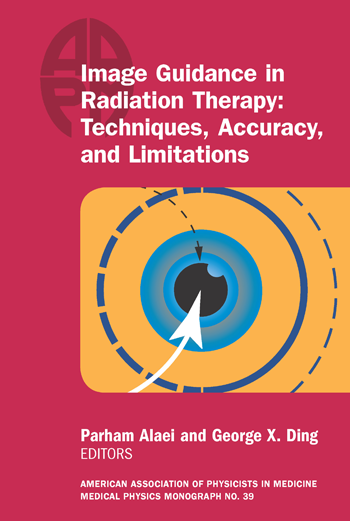
#39 Image Guidance in Radiation Therapy: Techniques, Accuracy, and Limitations, 2018 Summer School
Author: Parham Alaei, George DingISBN: 9781936366620
Published: July 2018 | 406 pp | Hardcover
Price: $ 120.00
Doody's | SEP 2019
Published in Doody's Review Services
Taoran Li, Ph.D.(University of Pennsylvania School of Medicine)
**Description**
Based on the proceedings of American Association of Physicists in Medicine 2018 Summer school, this book offers a comprehensive overview of the current technology, application, and development of image guidance in radiation therapy (IGRT). World experts in IGRT contribute chapters that address x-ray, surface, ultrasound, and MR imaging applications in guiding radiotherapy, as well as touching on fundamental algorithms, ongoing research, and future directions.
**Purpose**
The purpose is to provide an overview of all important image guidance technology in clinics, as well as emerging technologies that potentially will soon become available. This is definitely a much-needed book, as IGRT has become standard practice in the field, but there has not been a comprehensive summary based on up-to-date technologies, until this book. Because of the fast development and expansion of image guidance technologies, many physicists or trainees have limited or outdated knowledge of IGRT systems. The book covers a wide range of IGRT topics while maintaining the right amount of depth for the majority of readers, with detailed references for further reading. The discussions of limitations and future directions are also very interesting for researchers.
**Audience**
This book is appropriate for a wide range of audiences. Students and trainees learning about image guidance in medical physics will find it a great educational reference for basic principles and clinical applications of various imaging systems; active clinical physicists can refer to it for methodologies to assess an imaging system's performance and key specifications across current commercial solutions; and last but not the least, medical physics researchers will find the discussions of limitations very helpful and inspiring to ensure their research efforts are addressing pressing clinical needs. The contributors are world experts in their topics.
**Features**
After an overview, the book covers x-ray imaging, ultrasound imaging, imaging for proton therapy, imaging dose, surface guidance, image guidance for stereotactic treatments, and MR guidance. These topics comprehensively addressed nearly all aspects of image guidance in radiation therapy. One of the key features that distinguishes this book is the perfect blend of mathematics, physics, engineering, and application components that grabs readers' interest without overburdening them with too much information in any one area. This approach is apparent throughout the book but is particularly exemplified in chapters 2 and 6, where textbook level theory is presented in a clean and concise manner followed by very relevant practical knowledge. The book also covers up-to-date technology and development very well, including dual-energy CT simulation, digital thomosynthesis, proton range verification, and on MRgRT.
Even the latest technologies and commercial systems that have emerged in the last couple of years are covered, such as Halcyon platform, HumediQ, and RefleXion. Another feature that readers will find helpful is the inclusion of aggregated data tables to facilitate comparison of commercially available systems and options. Examples include chapter 8 on imaging dose across different vendors and protocols and on performance data on different surface guidance solutions, and chapter 16 on MRgRT systems. Clinical physicists will find this tabulated data convenient and informative when making purchase decisions, choosing treatment and imaging techniques, and estimating clinical impact from different systems. As for weaknesses, there is some minor overlap between imaging dose measurement methods across different chapters, and I would have liked to see a bit more detailed information on MR imaging theory and widely used pulse design in the chapters related to MR guidance. However, this does not detract from the quality of the book.
**Assessment**
This is a much-needed book that a wide range of audiences in the medical physics community will find essential. It is a timely summary of IGRT technology and serves well students, trainees, clinicians, and researchers. Clinicians will appreciate the up-to-date information on current state-of-the-art systems including specifications and applications; researchers will find the discussion of fundamental algorithms and current limitations inspiring and helpful; and, most importantly, students and trainees will benefit greatly from the comprehensiveness and superb clarity, especially those preparing for board examinations. The book is arranged logically, and the level of detail and depth of information is well balanced. It was genuinely enjoyable to read this book and to have it as a reference for routine clinical, educational, and research needs. It is a must-have for trainees preparing for ABR board exams. To the best of my knowledge, there is not an equivalent or comparable book on the market that is as clear, current, or complete. I highly recommend this book to all medical physicists.
-----------------------------------------------------------
Weighted Numerical Score: 93 - 4 Stars!


